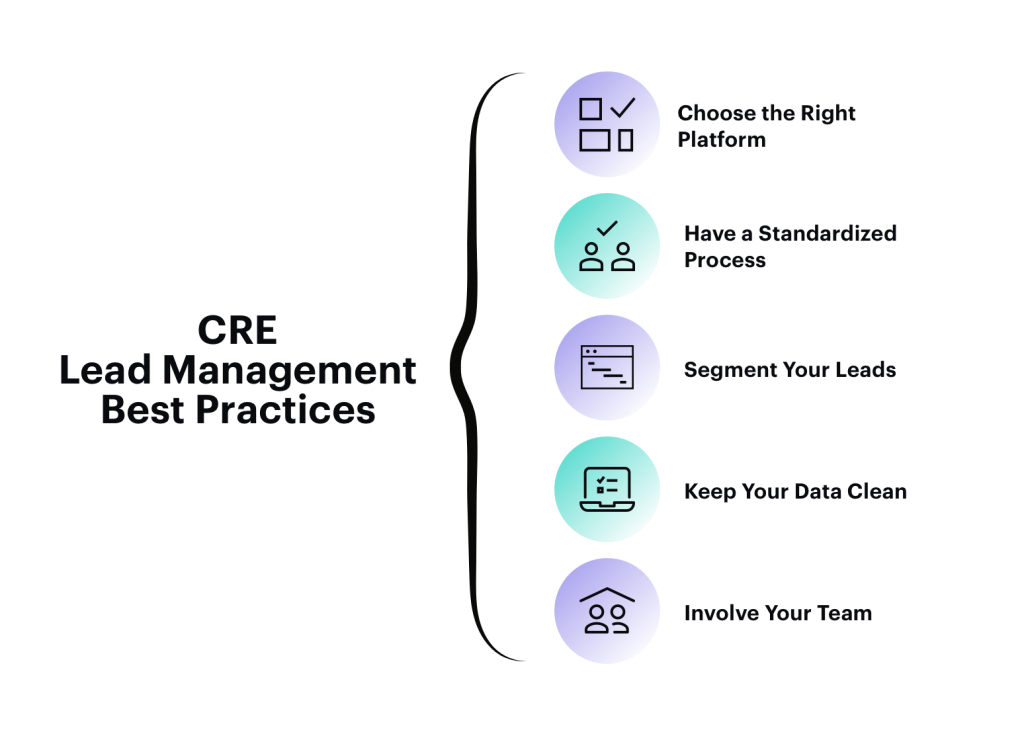
Marketing Best Practices
Lead Management: 5 Best Practices For CRE Teams
A lead management system or a customer relationship management system (CRM) should make your daily work easier.
It should streamline and remove extra steps that consume time you could use to engage with prospects and grow your business. If your CRM doesn’t do that, or if you are still using Excel to manage leads, consider the benefits of a dedicated lead management system designed for commercial real estate companies.
But how do you ensure you’re getting the most out of your CRM, and that it’s working for you instead of against you?
If you have an expensive CRM, and your team has spent hours migrating contacts and setting up rules, but isn’t following best lead management practices, you’re probably wasting both time and money.
Let’s take a closer look at key best practices to get the most out of your system and how the right software can support your efforts.
Best Practices to Get the Most Out of Your Lead Management System

1. Choose the Right Platform that Fits your Needs
There are hundreds of lead management platforms out there, but in the commercial real estate industry, few of them are designed for the specific needs of your business.
When choosing a generic CRM, there are several challenges you’ll need to address:
- They tend to be bloated with features you’ll never use, making them difficult to manage
- User adoption becomes a challenge because of how intricate the interface is
- Customization is often required to meet the very specific nature of your business
Salesforce is a prime example. It’s well known because it’s the world’s largest CRM, but that popularity means it’s designed to fit the needs of everyone. You don’t need a system that fits the needs of everyone. You need one for commercial real estate.
When choosing a platform, ask yourself how much time and resources you have to invest in adoption and implementation. If the answer is “not very much,” consider a more intuitive solution designed specifically for your business. A lead management system for CRE, for example, allows you to assign new contacts to specific properties.
2. Have a Standardized Process
This is a universal problem that plagues almost all types of businesses.
Every salesperson has their own process, which in turn makes reporting, lead management, and data transfer incredibly difficult. A standardized lead management process helps to minimize errors, streamlines operations and builds a foundation on which you can build future sales, marketing, and tenant management processes.
To ensure everyone is on the same page, gather your entire team, and craft a comprehensive process for lead management in your organization. Cover the following areas:
- Define what is a lead – When does a contact enter your system, and once they are in your system, when do you define them as leads? Is it after they have requested certain information? Once a call has been scheduled? Or is every contact in your system a viable lead?
- Qualify your leads – Once someone is considered a lead, what steps do you take to qualify them? What information needs to be included on their contact record and who will do the qualifying?
- Respond to inquiries in a timely manner – If someone has questions that they submit by a form on your website, or they make a phone call, who is responsible for following up and in what time frame?
- Add notes to track communication – Notes should be added whenever a member of your team communicates with a prospect. Whether it’s a phone call that wasn’t answered, or an in-depth email received in response to a query. Association with individual properties should be kept updated at all times as well.
- Move leads into stages to track progress – When a lead progresses in your sales process, update their record to reflect that change. This can be in the form of lifecycle stages, opportunity stages, or just a property added to a contact to show they have progressed.
3. Segment Your Leads
No two leads are the same. Everyone in your sales funnel is at a different stage, with different needs and different follow-up requirements. This is a good thing. This means you can create segmentation in your lead management process that helps to streamline a lot of the things you do every day.
For example, you can organize your leads by:
- Pipeline stages – Is a meeting scheduled? Has the meeting happened? Have they viewed certain documents or voiced interest beyond an initial call? Create stages to reflect these steps and update accordingly.
- Tags – Use tags to identify leads by various properties, such as location, interest, specific properties, or demographics.
- Activity filters – Filter activity levels to prioritize those leads that are more actively engaging with your website and marketing and sales efforts.
The benefit of a CRM is that, no matter how intricately you want to segment and communicate with your leads, the tools are there to do so.
4. Keep Your Data Clean
One of the quickest ways to undermine your lead management processes is to ignore your data for too long.
Messy data with outdated records, inaccurate assignments, and missing information can make everything else you do less effective and more time-consuming. Create recurring tasks for each of the following:
- Clean Up Bounced and Unsubscribed Emails – Check all bounced emails to see if someone has changed companies or otherwise. Remove any emails you cannot update in the system or that have proactively unsubscribed from communications.
- Update Contact Records – Regularly audit your contact records for accuracy. Check that there are no missing properties and that all contact information is up to date.
- Check for Inactive Contact Owners – Make sure all contacts in your system are assigned to someone. If someone leaves your organization, these orphaned leads can get forgotten.
- Build a Data Plan within Your Organization – Clearly define what data is important and ensure it is captured by all relevant members of your team. If you need to know the phone number of every contact in your system, for example, ensure it’s set as such during contact creation.
5. Involve Your Team
Another major stumbling block for even the best lead management processes is adoption. In a fast-paced environment like commercial real estate, it can be difficult to get buy-in from every member of your team overnight. But the more resources you provide and support you offer to those who are new to the system, the faster they will adopt the new processes, and the more effective your systems will be.
How do you do this?
You focus on collaboration. No one is the “sole owner” of a lead. At any point, someone in marketing might use contact properties to populate a campaign. Someone in tenant management might review a record or leave a note. So it’s important to emphasize that this is a collaborative effort and that everyone is helping the team as a whole to perform better by using a CRM effectively.
If more users can add notes, comments, and activities, more information is available for every lead, and each person can do their job better.
Getting the Most from Your Lead Management System
The right commercial real estate lead management system can help improve almost every aspect of your business. It provides an easy-to-use system with only the tools and features needed for commercial real estate transactions and tenant management.
Related Blog Posts
CRE Technology
5 Reasons Why Salesforce Needs a CRE Marketing Platform
Salesforce isn’t only the most widely used CRM, it’s also the leading choice in the...
Company updates
Streamline Your Outreach with Tag-Based Email Campaigns
We are thrilled to announce the launch of our new Tag-Based Email Campaign feature, designed...
Company updates
SharpLaunch Announces New Integration with LandSearch
We’re excited to announce a groundbreaking integration with LandSearch, a prominent online...


